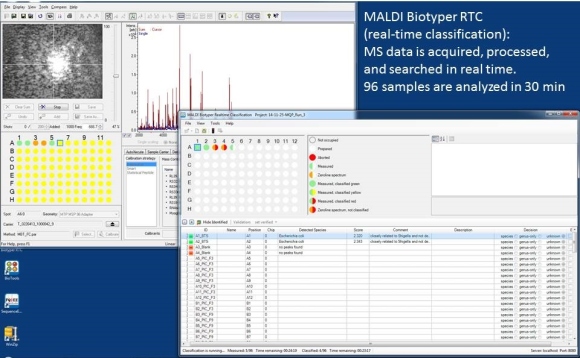We have updated the Biotyper library which now contains 6903 entries. More than 80 new yeast MSPs and more than 400 each Gram positive and Gram negative bacterial MSPs were included in this update.
Tag Archives: microorganism identification
Biotyper sample submission guidelines
The list of supplies and basic protocols for Biotyper can be found at the end of this post. In addition, the Biotyper manual in pdf format is available upon request. The Facility does not provide any of the supplies on this list and can only accept MS-ready target plates. For a demo on preparing the target plates, contact Tatiana.
To expedite your analysis, please fill out the Excel Sample ID Template with your sample names exactly as shown. All missing or incorrectly filled sample names will be replaced by the analysis date and your initials. You are responsible for keeping a record of your sample positions. The Excel file with the sample IDs must be emailed to Tatiana. Please attach any other information as separate files or documents.
Tips for successful microorganism identification
It is very important to exactly follow the procedure and use only the fresh, specified-grade reagents and solutions. MALDI is a competitive ionization process and is very sensitive to contaminants commonly present in histology-grade solvents and low-purity chemicals.
More is not better. A correct ratio of matrix to analyte is critical and achieved by following the procedure exactly.
Tube extraction (formic acid extraction) procedure requires extra few minutes of the prep time but yields much better results than the direct transfer procedure. Direct transfer procedure requires practice and is only applicable to non-spore-forming microorganisms. We recommend following the tube extraction procedure for all samples.
If you have any questions or suggestions or would like to discuss your project details, please email or call Tatiana.
Shipping the target plates
Plates can be shipped overnight on wet ice packs. To protect the sample spots, place the target plate facing down into its original box. You can tape it, so it does not get dislodged during shipping.

Biotyper
The MALDI Biotyper identifies microorganisms by analyzing their intrinsic proteins using mass spectrometry.
An individual colony from an overnight culture grown on an agar plate is picked using a wooden toothpick and transferred to a MALDI target. This sample is allowed to dry, and a microliter of a matrix solution is added to the sample. The organic solvent in the matrix solution extracts proteins from the microorganisms. The extracted proteins are mainly ribosomal proteins, present in high concentrations. Once the matrix has crystallized, sample preparation is complete and the samples are ready for analysis. For some microorganisms, it is necessary to perform a more extensive extraction, which adds another 10-15 minutes to the sample preparation procedure.
In our facility, the analyses are carried out on the Bruker Ultraflextreme MALDI TOF/TOF mass spectrometer. Each MALDI mass spectrum is a species-specific molecular fingerprint, a mass and intensity distribution of peaks corresponding to mainly ribosomal proteins.

Microorganisms are identified in real time as soon as data are collected from each individual target position.
Identification of an unknown microorganism is based on comparing the experimental molecular fingerprint with 6903 fingerprints in the Biotyper library and assigning a score which represents the probability that the match is correct.

Off-line classification software provides additional options for working with data such as creating new library entries, re-organizing libraries, viewing mass spectra, or assessing quality of match.
The algorithm used to compare patterns computes three separate values for three fundamental characteristics of the sample spectra and the reference spectra: the number of signals in the reference spectrum that have a closely matching partner in the unknown spectrum; the number of signals in the unknown spectrum that have a closely matching partner in the reference spectrum; and the intensity symmetry of the matching pairs. The maximum obtainable score is 3, and the score values greater or equal to 2 are considered as a probable identification.

Each mass spectrum is converted into a histogram which represents the mass and intensity ‘fingerprint’.
Biotyper software allows building spectral libraries of any type of samples as long as the samples are amenable to MALDI-TOF MS and produce unique MS fingerprints. If you are interested in learning more about MALDI MS and the Biotyper, please contact Tatiana.
The acquisition of MALDI Biotyper software was possible through collaboration with Dr. Bhushan M. Jayarao, Director of Penn State Animal Diagnostic Laboratory, Professor of Veterinary and Biomedical Sciences.
Featured image credit: Rocky Mountain Laboratories, NIAID, NIH
Scanning electron micrograph of Escherichia coli, grown in culture and adhered to a coverslip

